Assessment of Leaf Area Index of Rice for a Growing Cycle Using Multi-Temporal C-Band PolSAR Datasets
Abstract
1. Introduction
2. Materials and Methods
2.1. Study Area and In Situ Observation
2.2. RADARSAT-2 Datasets and Polarimetric Parameters
2.3. Method of Data Analysis and Model Construction
3. Results
3.1. Phenological Variation of Ground Measured Rice LAI and Polarimetric SAR Variables
3.2. Regression Analyses between Rice LAI and Polarimetric Parameters
3.3. Model Development and Validation
4. Discussion
5. Conclusions
Author Contributions
Funding
Conflicts of Interest
References
- Chen, C.; Son, N.T.; Chang, L. Monitoring of rice cropping intensity in the upper Mekong Delta, Vietnam using time-series MODIS data. Adv. Space Res. 2012, 49, 292–301. [Google Scholar] [CrossRef]
- Chen, J.M.; Black, T.A. Defining leaf area index for non-flat leaves. Plant Cell Environ. 1992, 15, 421–429. [Google Scholar] [CrossRef]
- Quan, X.; He, B.; Yebra, M.; Yin, C.; Liao, Z.; Zhang, X. A radiative transfer model-based method for the estimation of grassland aboveground biomass. Int. J. Appl. Earth Obs. Geoinf. 2017, 54, 159–168. [Google Scholar] [CrossRef]
- Demarez, V.; Duthoit, S.; Baret, F.; Weiss, M.; Dedieu, G. Estimation of leaf area and clumping indexes of crops with hemispherical photographs. Agric. Forest Meteorol. 2008, 148, 644–655. [Google Scholar] [CrossRef]
- Zeng, Y.; Li, J.; Liu, Q.; Hu, R.; Mu, X.; Fan, W.; Xu, B.; Yin, G.; Wu, S. Extracting Leaf Area Index by Sunlit Foliage Component from Downward-Looking Digital Photography under Clear-Sky Conditions. Remote Sens. 2015, 7, 13410. [Google Scholar] [CrossRef]
- Tang, H.; Brolly, M.; Zhao, F.; Strahler, A.H.; Schaaf, C.L.; Ganguly, S.; Dubayah, R. Deriving and validating Leaf Area Index (LAI) at multiple spatial scales through Lidar remote sensing: A case study in Sierra National Forest, CA. Remote Sens. Environ. 2014, 143, 131–141. [Google Scholar] [CrossRef]
- Zeng, Y.; Li, J.; Liu, Q.; Qu, Y.; Huete, A.R.; Xu, B.; Yin, G.; Zhao, J. An Optimal Sampling Design for Observing and Validating Long-Term Leaf Area Index with Temporal Variations in Spatial Heterogeneities. Remote Sens. 2015, 7, 1300–1319. [Google Scholar] [CrossRef]
- Hosseini, M.; McNairn, H.; MerzouKi, A.; PacHeco, A. Estimation of Leaf Area Index (LAI) in corn and soybeans using multi-polarization C- and L-band radar data. Remote Sens. Environ. 2015, 170, 77–89. [Google Scholar] [CrossRef]
- Mulla, d.J. Twenty five years of remote sensing in precision agriculture: Key advances and remaining knowledge gaps. Biosyst. Eng. 2013, 114, 358–371. [Google Scholar] [CrossRef]
- Manninen, T.; Stenberg, P.; Rautiainen, M.; Voipio, P.; Smolander, H. Leaf area index estimation of boreal forest using ENVISAT ASAR. IEEE Trans. Geosci. Remote Sens. 2005, 43, 2627–2635. [Google Scholar] [CrossRef]
- He, B.B.; Quan, X.W.; Xing, M.F. Retrieval of leaf area index in alpine wetlands using a two-layer canopy reflectance model. Int. J. Appl. Earth Obs. Geoinf. 2013, 21, 78–91. [Google Scholar] [CrossRef]
- Quan, X.; He, B.; Li, X. A Bayesian network-based method to alleviate the ill-posed inverse problem: A case study on leaf area index and canopy water content retrieval. IEEE Trans. Geosci. Remote Sens. 2015, 53, 6507–6517. [Google Scholar] [CrossRef]
- Wu, M.; Zhang, X.; Huang, W.; Niu, Z.; Wang, C.; Li, W.; Hao, P. Reconstruction of daily 30 m data from HJ CCD, GF-1 WFV, Landsat, and MODIS data for crop monitoring. Remote Sens. 2015, 7, 16293–16314. [Google Scholar] [CrossRef]
- Wu, M.; Yang, C.; Song, X.; Hoffmann, W.C.; Huang, W.; Niu, Z.; Wang, C.; Li, W.; Yu, B. Monitoring cotton root rot by synthetic sentinel-2 NDVI time series using improved spatial and temporal data fusion. Sci. Rep. 2018, 8, 2016. [Google Scholar] [CrossRef] [PubMed]
- Li, S.; Xiao, J.; Ni, P.; Zhang, J.; Wang, H.; Wang, J. Monitoring paddy rice phenology using time series MODIS data over Jiangxi Province, China. Int. J. Agric. Biol. Eng. 2014, 7, 28–36. [Google Scholar] [CrossRef]
- Li, S.; Ni, P.; Cui, G.; He, P.; Liu, H.; Li, L.; Liang, Z. Estimation of rice biophysical parameters using multitemporal RADARSAT-2 images. In Proceedings of the Symposium of the International Society for Digital Earth (ISDE), Halifax, NS, Canada, 5–9 October 2015; p. 012019. [Google Scholar]
- Ahmadian, N.; Borg, E.; Roth, A.; Zölitz, R. Estimating the Leaf Area Index of Agricultural Crops using multi-temporal dual-polarimetric TerraSAR-X Data: A case study in North-Eastern Germany. Photogramm. Fernerkun. 2016, 2016, 301–317. [Google Scholar] [CrossRef]
- Chen, J.; Lin, H.; Huang, C.; Fang, C. The relationship between the leaf area index (LAI) of rice and the C-band SAR vertical/horizontal (VV/HH) polarization ratio. Int. J. Remote Sens. 2009, 30, 2149–2154. [Google Scholar] [CrossRef]
- Asilo, S.; Nelson, A.; de Bie, K.; Skidmore, A.; Laborte, A.; Maunahan, A.; Quilang, E.J.P. Relating X-band SAR backscattering to leaf area index of rice in different phenological phases. Remote Sens. 2019, 11, 1462. [Google Scholar] [CrossRef]
- Suga, Y.; Konishi, T. Rice crop monitoring using X, C and L band SAR data. In Remote Sensing for Agriculture, Ecosystems, and Hydrology X, Proceedings of SPIE, Cardiff, Wales, UK, 16–18 September 2008; International Society for Optics and Photonics: Bellingham, DC, USA, 2008; p. 710410. [Google Scholar]
- Jiao, X.; Mcnairn, H.; Shang, J.; Pattey, E.; Liu, J.; Champagne, C. The sensitivity of RADARSAT-2 polarimetric SAR data to corn and soybean leaf area index. Can. J. Remote Sens. 2011, 37, 69–81. [Google Scholar] [CrossRef]
- Leonard, A.; Beriaux, E.; Pierre, D. Complementarity of linear polarizations in C-band SAR imagery to estimate leaf area index for maize and winter wheat. In ESA Living Planet Symposium 2013, Proceedings of European Space Agency (ESA), Edinburgh, UK, 9–13 September 2013; Esa Communications Ltd.: Oakville, ON, Canada, 2013; p. 722. [Google Scholar]
- Cable, J.; Kovacs, J.; Shang, J.; Jiao, X. Multi-temporal polarimetric RADARSAT-2 for land cover monitoring in northeastern Ontario, Canada. Remote Sens. 2014, 6, 2372–2392. [Google Scholar] [CrossRef]
- He, Z.; Li, S.; Wang, Y.; Dai, L.; Lin, S. Monitoring Rice Phenology Based on Backscattering Characteristics of Multi-Temporal RADARSAT-2 Datasets. Remote Sens. 2018, 10, 340. [Google Scholar] [CrossRef]
- Hirooka, Y.; Homma, K.; Maki, M.; Sekiguchi, K. Applicability of synthetic aperture radar (SAR) to evaluate leaf area index (LAI) and its growth rate of rice in farmers’ fields in Lao PDR. Field Crop Res. 2015, 176, 119–122. [Google Scholar] [CrossRef]
- Kim, Y.; Jackson, t.; Bindlish, R.; Lee, H.; Hong, C. Monitoring soybean growth using L-, C-, and X-band scatterometer data. J. Appl. Remote Sens. 2013, 34, 4069–4082. [Google Scholar] [CrossRef]
- Paloscia, S. An empirical approach to estimating leaf area index from multifrequency SAR data. Int. J. Remote Sens. 1998, 19, 359–364. [Google Scholar] [CrossRef]
- Baghdadi, N.N.; Hajj, M.E.; Zribi, M.; Fayad, I. Coupling SAR C-band and optical data for soil moisture and leaf area index retrieval over irrigated grasslands. IEEE J. Sel. Top. Appl. Earth Observ. Remote Sens. 2016, 9, 1229–1243. [Google Scholar] [CrossRef]
- Kumar, V.; Mamta, K.; Sudip, K.S. Leaf area index estimation of lowland rice using semi-empirical backscattering model. J. Appl. Remote Sens. 2013, 7, 447–456. [Google Scholar] [CrossRef]
- Inoue, Y.; Sakaiya, E.; Wang, C. Capability of C-band backscattering coefficients from high-resolution satellite SAR sensors to assess biophysical variables in paddy rice. Remote Sens. Environ. 2014, 140, 257–266. [Google Scholar] [CrossRef]
- Yang, S.; Zhao, X.; Li, B.; Hua, G. Interpreting RADARSAT-2 quad-polarization SAR signatures from rice paddy based on experiments. IEEE Geosci. Remote Sens. Lett. 2012, 9, 65–69. [Google Scholar] [CrossRef]
- Lin, H.; Chen, J.; Pei, Z.; Zhang, S.; Hu, X. Monitoring sugarcane growth using ENVISAT ASAR data. IEEE Trans. Geosci. Remote Sens. 2009, 47, 2572–2580. [Google Scholar] [CrossRef]
- Adams, J.R.; Rowlandson, T.L.; Mckeown, S.J.; Berg, A.A.; Mcnairn, H.; Sweeney, S.J. Evaluating the Cloude-Pottier and Freeman-Durden scattering decompositions for distinguishing between unharvested and post-harvest agricultural fields. Can. J. Remote Sens. 2014, 39, 318–327. [Google Scholar] [CrossRef]
- Cable, J.; Kovacs, J.; Jiao, X.; Shang, J. Agricultural monitoring in northeastern Ontario, Canada, using multi-temporal polarimetric RADARSAT-2 data. Remote Sens. 2014, 6, 2343–2371. [Google Scholar] [CrossRef]
- Cloude, S.R.; Pottier, E. An entropy based classification scheme for land applications of polarimetric SAR. IEEE Trans. Geosci. Remote Sens. 1997, 35, 68–78. [Google Scholar] [CrossRef]
- Freeman, A.; Durden, S.L. A Three-Component Scattering Model for Polarimetric SAR Data. IEEE Trans. Geosci. Remote Sens. 1998, 36, 963–973. [Google Scholar] [CrossRef]
- Zhang, L.; Guo, H.; Li, X. Simulation analysis on the relationship between the leaf area index and polarimetric parameters of crops. Int. J. Digit. Earth 2012, 5, 319–337. [Google Scholar] [CrossRef]
- Francis, C.; Richard, F. ALOS PALSAR L-band polarimetric SAR data and in situ measurements for leaf area index assessment. Remote Sens. Lett. 2012, 3, 221–229. [Google Scholar] [CrossRef]
- Manninen, T.; Stenberg, P.; Rautiainen, M.; Voipio, P. Leaf area index estimation of boreal and subarctic forests using VV/HH ENVISAT/ASAR data of various swaths. IEEE Trans. Geosci. Remote Sens. 2013, 51, 3899–3909. [Google Scholar] [CrossRef]
- Zadoks, J.C.; Chang, T.T.; Konzak, C.F. A decimal code for the growth stages of cereals. Weed Res. 1974, 14, 415–421. [Google Scholar] [CrossRef]
- Kim, Y.; Jackson, T.; Bindlish, R.; Lee, H.; Hong, S. Radar vegetation index for estimating the vegetation water content of rice and soybean. IEEE Geosci. Remote Sens. Lett. 2012, 9, 564–568. [Google Scholar] [CrossRef]
- Francis, C.; Shang, J.; Liu, J.; Huang, X.; Ma, B.; Jiao, X.; Geng, X.; John, M.K.; Dan, W. Tracking crop phenological development using multi-temporal polarimetric Radarsat-2 data. Remote Sens. Environ. 2017, 210, 508–518. [Google Scholar] [CrossRef]
- Pacheco, A.; McNairn, H.; Li, Y.; Lampropoulos, G.; Powers, J. Using RADARSAT-2 and TerraSAR-X satellite data for the identification of canola crop phenology. SPIE Remote Sens. 2016, 9998, 999802. [Google Scholar] [CrossRef]
- Van Zyl, J.J. Application of Cloude’s target decomposition theorem to polarimetric imaging radar. In Radar Polarimetry, Proceedings of SPIE, San Diego, CA, USA, 12 February 1993; SPIE: Bellingham, DC, USA, 1993; pp. 184–191. [Google Scholar]
- Xu, T.; Liao, J.; Shen, G.; Wang, J.; Yang, X.; Wang, M. Estimation of wetland vegetation LAI in the Poyang Lake area using GF-1 and RADARSAT-2 data. J. Infrared Millim. Waves 2016, 35, 332–340. [Google Scholar] [CrossRef]
- Ballester-Berman, J.D.; Lopez-Sanchez, J.M. Applying the Freeman–Durden decomposition concept to polarimetric SAR interferometry. IEEE Trans. Geosci. Remote Sens. 2009, 48, 466–479. [Google Scholar] [CrossRef]
- An, W.; Cui, Y.; Yang, J. Three-component model-based decomposition for polarimetric SAR data. IEEE Trans. Geosci. Remote Sens. 2010, 48, 2732–2739. [Google Scholar] [CrossRef]
- Kim, Y.; van Zyl, J.J. A time-series approach to estimate soil moisture using polarimetric radar data. IEEE Trans. Geosci. Remote Sens. 2009, 47, 2519–2527. [Google Scholar] [CrossRef]
- Lopez-Sanchez, J.M.; Vicente-Guijalba, F.; Ballester-Berman, J.D.; Cloude, S.R. Polarimetric response of rice fields at C-band: Analysis and phenology retrieval. IEEE Trans. Geosci. Remote Sens. 2014, 52, 2977–2993. [Google Scholar] [CrossRef]
- Lopez-Sanchez, J.M.; Cloude, S.R.; Ballester-Berman, J.D. Rice phenology monitoring by means of SAR polarimetry at X-band. IEEE Trans. Geosci. Remote Sens. 2012, 50, 2695–2709. [Google Scholar] [CrossRef]
- Wang, L.; Kong, J.; Ding, K.; Le Toan, T.; Ribbes-Baillarin, F.; Floury, N. Electromagnetic scattering model for rice canopy based on Monte Carlo simulation. Prog. Electromagn. Res. 2005, 52, 153–171. [Google Scholar] [CrossRef]
- Koppe, W.; Gnyp, M.L.; Hütt, C.; Yao, Y.; Miao, Y.; Chen, X.; Bareth, G. Rice monitoring with multi-temporal and dual-polarimetric TerraSAR-X data. Int. J. Appl. Earth Obs. Geoinf. 2013, 21, 568–576. [Google Scholar] [CrossRef]
- Inoue, Y.; Kurosu, T.; Maeno, H.; Uratsuka, S.; Kozu, T.; Dabrowska-Zielinska, K.; Qi, J. Season-long daily measurements of multifrequency (Ka, Ku, X, C, and L) and full-polarization backscatter signatures over paddy rice field and their relationship with biological variables. Remote Sens. Environ. 2002, 81, 194–204. [Google Scholar] [CrossRef]
- Fieuzal, R.; Baup, F. Estimation of leaf area index and crop height of sunflowers using multi-temporal optical and SAR satellite data. Int. J. Remote Sens. 2016, 37, 2780–2809. [Google Scholar] [CrossRef]
- Jiao, X.; McNairn, H.; Shang, J.; Pattey, E.; Liu, J.; Champagne, C. The sensitivity of RADARSAT-2 quad-polarization SAR data to crop LAI. In Remote Sensing and Modeling of Ecosystems for Sustainability VI, Proceedings of SPIE, San Diego, CA, USA, 5–6 August 2009; SPIE: Bellingham, DC, USA, 2009; p. 74540O. [Google Scholar]
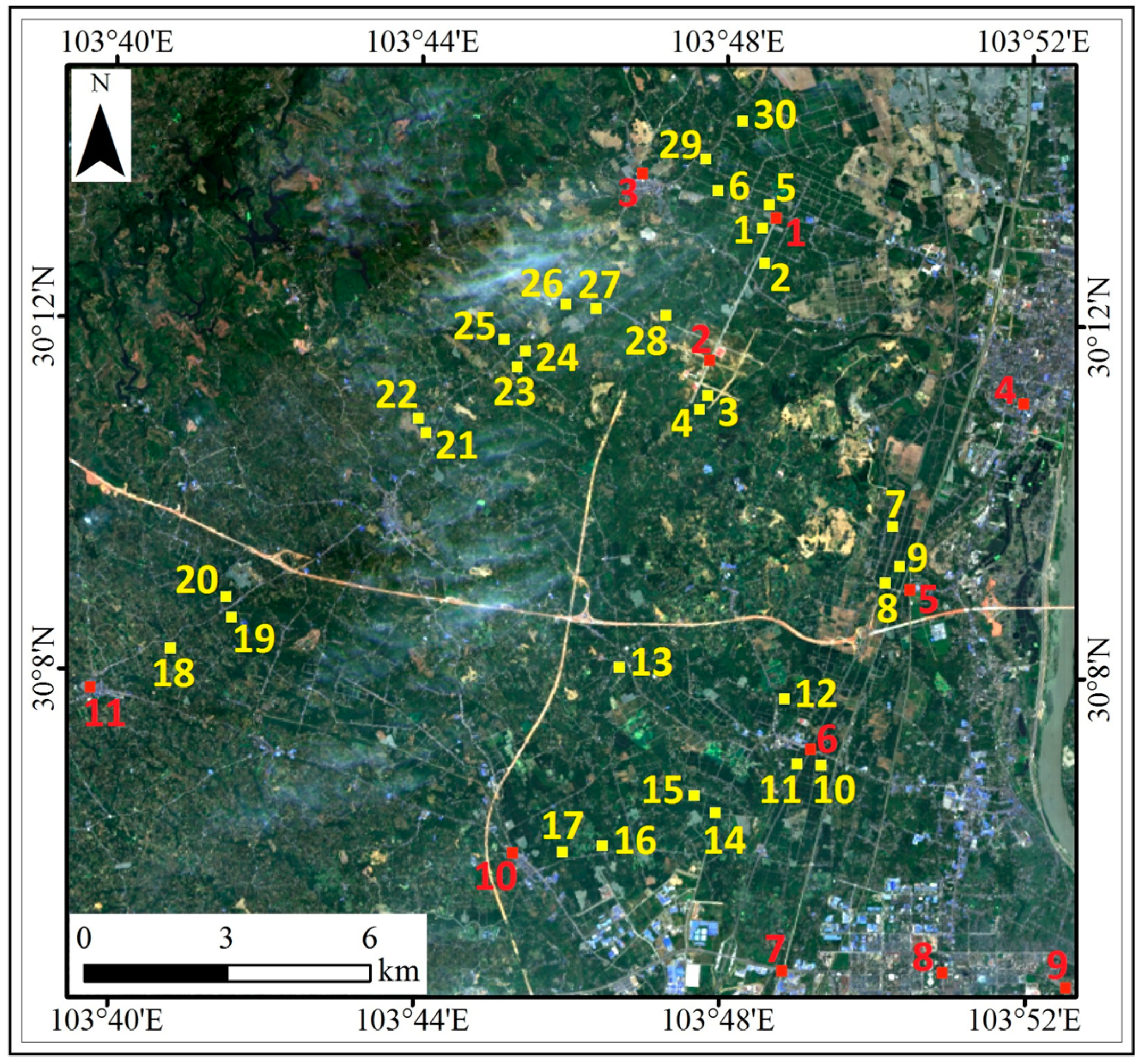
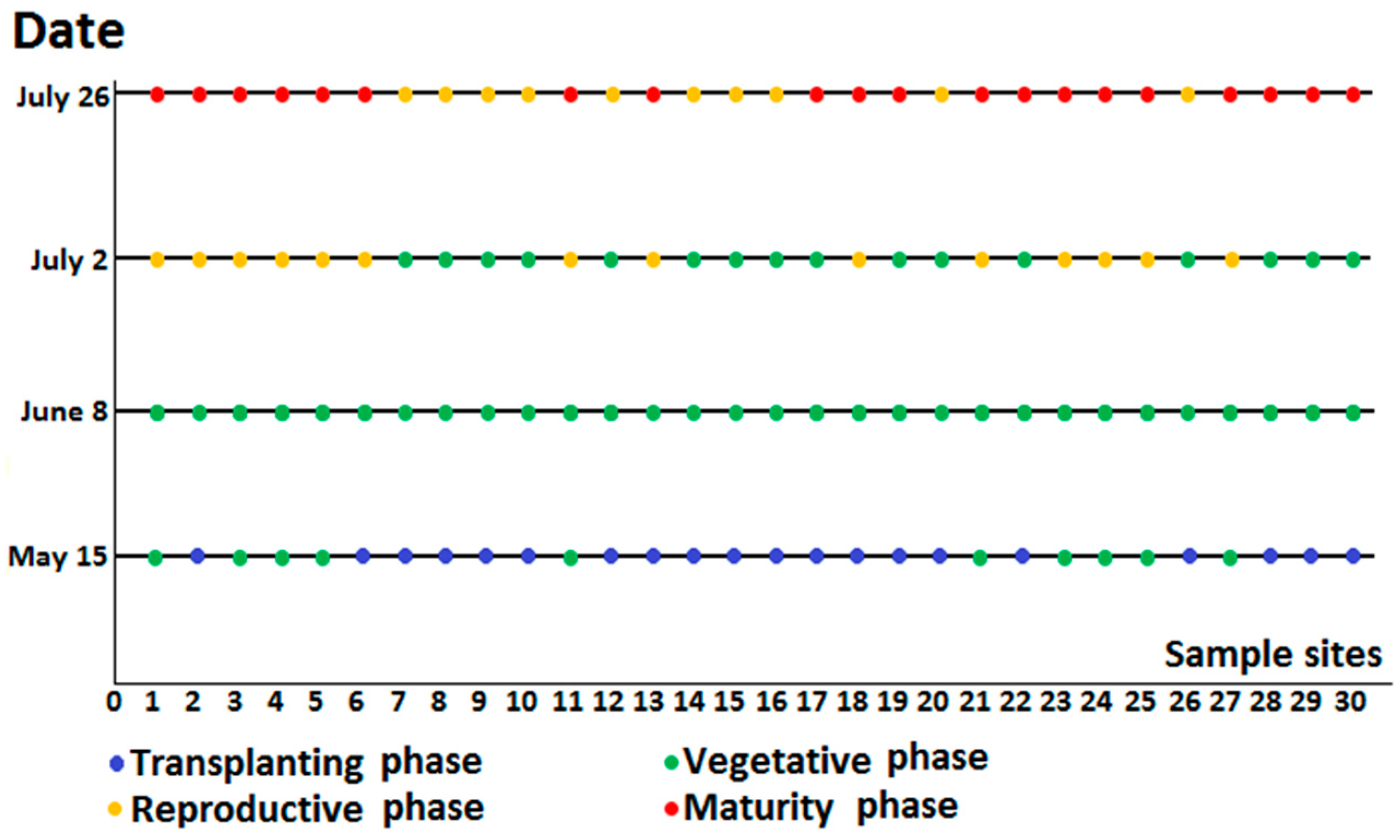

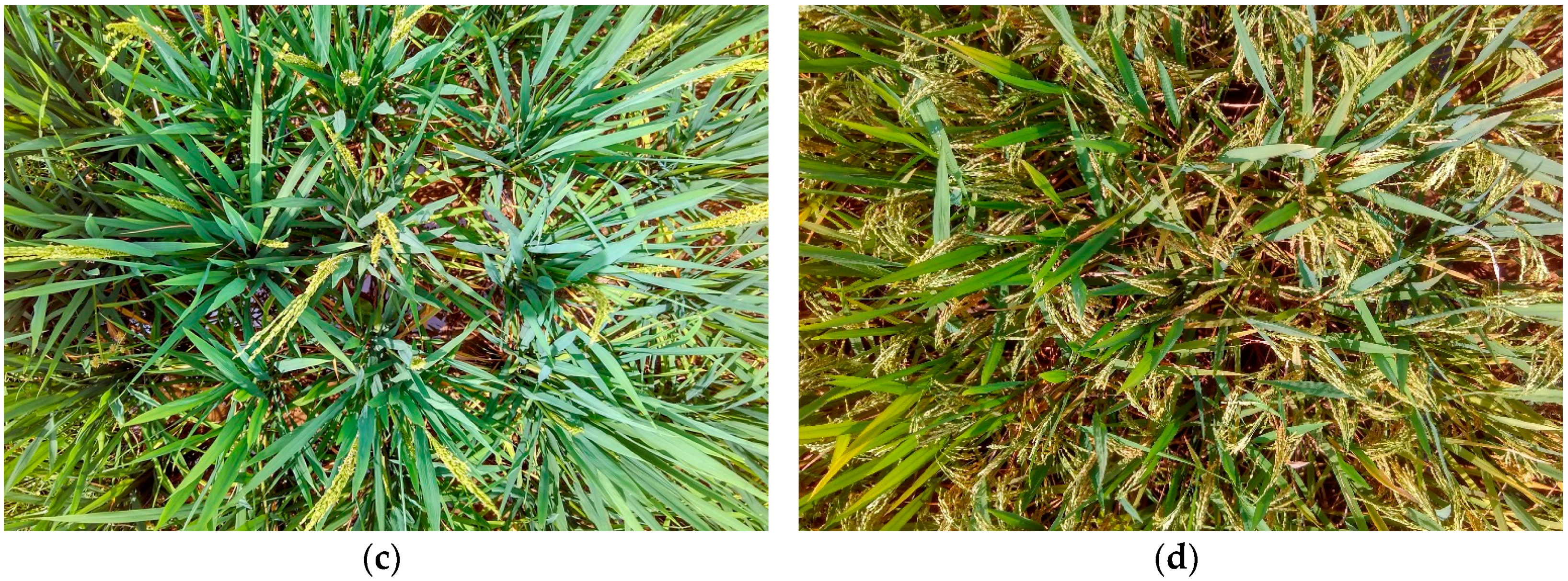
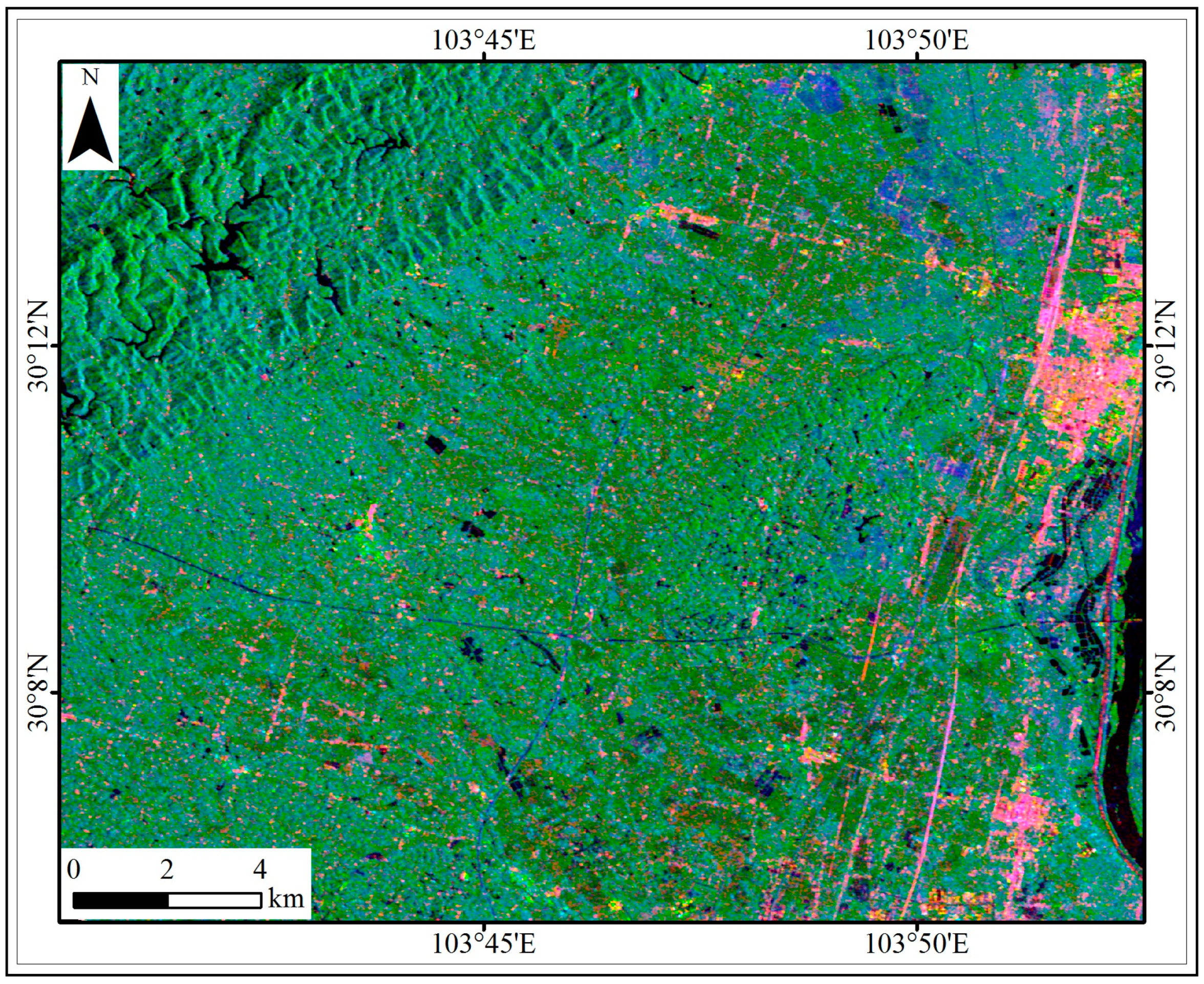
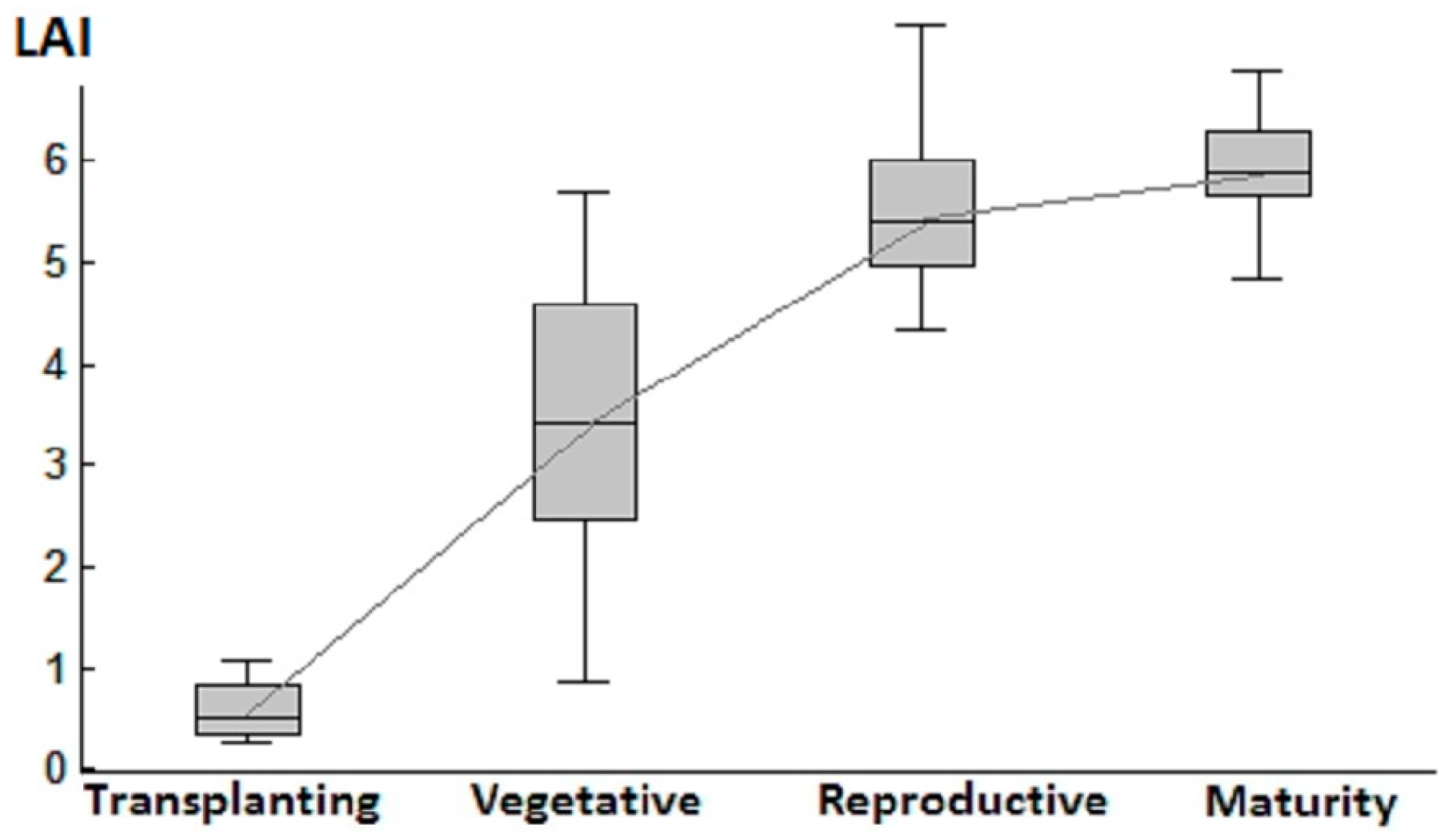
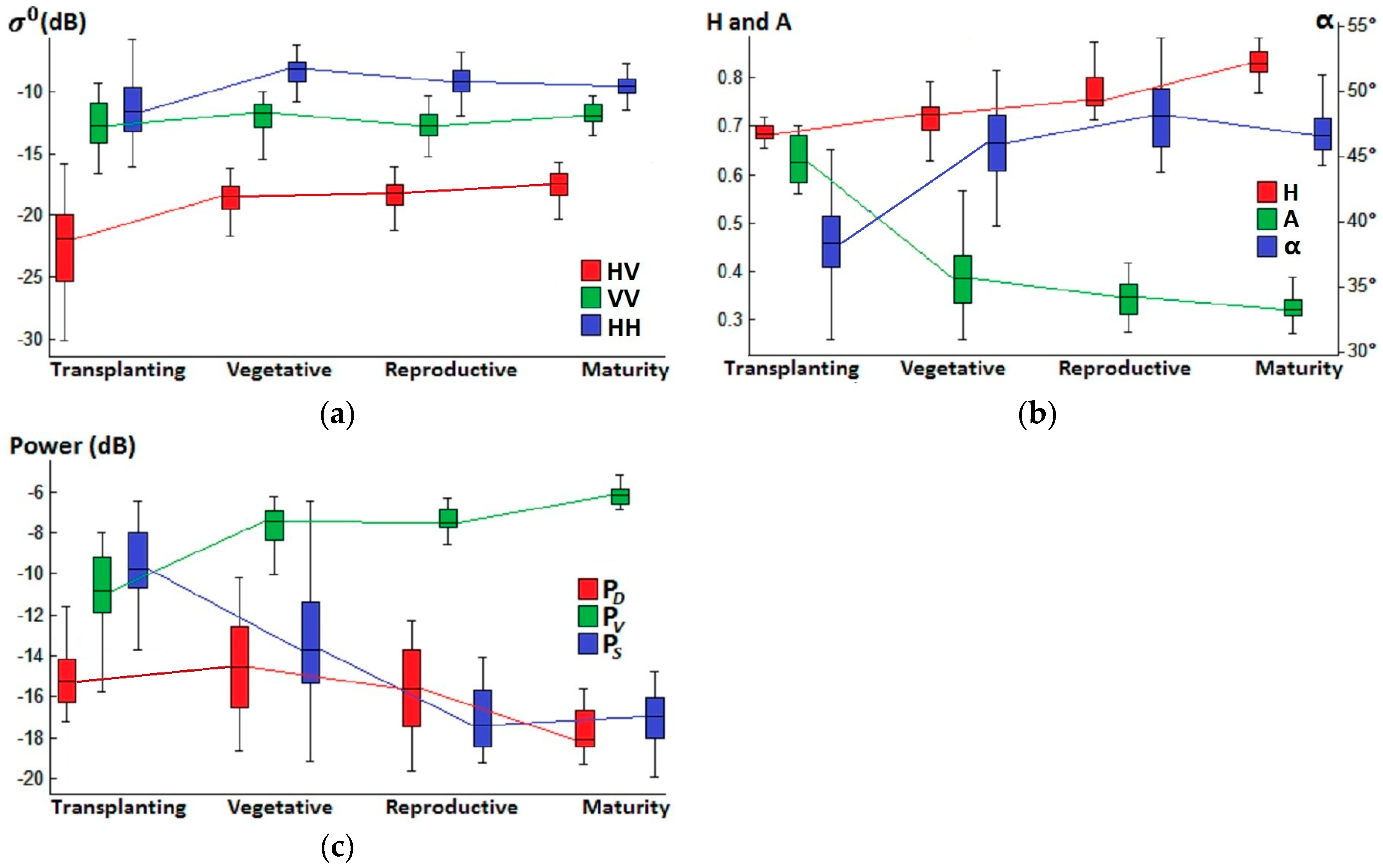


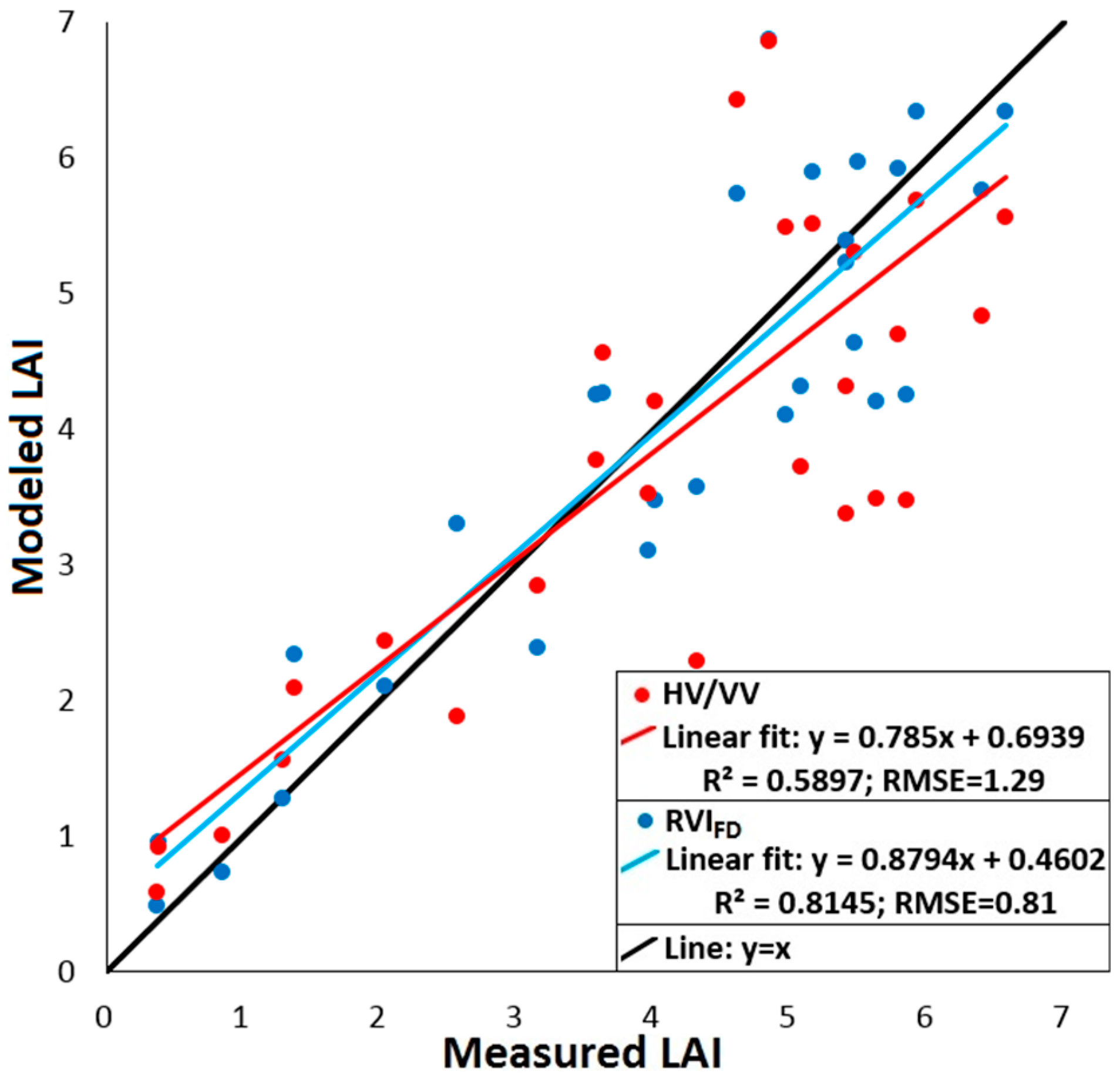
| Principle Phase | BBCH | Name |
|---|---|---|
| Transplanting | 00–09 | Germination |
| 10–19 | Leaf development | |
| Vegetative | 20–29 | Tillering |
| 30–39 | Stem elongation | |
| 40–49 | Booting | |
| Reproductive | 50–59 | Heading |
| 60–69 | Flowering | |
| Maturity | 70–79 | Development of fruit |
| 80–89 | Ripening | |
| 90–99 | Senescence |
| Coefficients of Determination (R2) | |||||
|---|---|---|---|---|---|
| Transplanting | Vegetative | Reproductive | Maturity | Entire Growth Cycle | |
| HV | 0.25 L | 0.16 E* | 0.34 L* | 0.00 L | 0.52 E* |
| VV | 0.30 L | 0.45 L* | 0.36 L* | 0.00 E | 0.08 P* |
| HH | 0.43 L | 0.01 E | 0.48 L* | 0.26 E | 0.13 P* |
| HV/HH | 0.17 L | 0.16 E* | 0.09 L | 0.14 E | 0.56 P* |
| HV/VV | 0.03 L | 0.75 E* | 0.09 L | 0.02 L | 0.81 E* |
| VV/HH | 0.20 L | 0.52 E* | 0.01 L | 0.18 E | 0.15 E* |
| 0.06 E | 0.50 E* | 0.10 L | 0.03 E | 0.70 L* | |
| H | 0.02 E | 0.04 L | 0.07 L | 0.08 E | 0.34 P* |
| A | 0.12 E | 0.58 E* | 0.00 L | 0.07 N | 0.63 E* |
| α | 0.05 L | 0.18 E* | 0.02 E | 0.00 L | 0.43 E* |
| 0.16 N | 0.26 E* | 0.02 N | 0.00 E | 0.60 P* | |
| 0.33 L | 0.33 L* | 0.21 L | 0.05 E | 0.31 L* | |
| 0.12 L | 0.40 E* | 0.23 L | 0.00 E | 0.62 P* | |
| 0.09 L | 0.15 E* | 0.40 L* | 0.02 L | 0.51 E* | |
| / | 0.03 L | 0.03 E | 0.00 L | 0.04 L | 0.21 E* |
| / | 0.05 L | 0.35 L* | 0.06 L | 0.05 E | 0.54 P* |
| / | 0.03 E | 0.54 E* | 0.07 L | 0.04 E | 0.77 P* |
| 0.05 E | 0.68 E* | 0.11 L | 0.04 E | 0.84 E* | |
© 2019 by the authors. Licensee MDPI, Basel, Switzerland. This article is an open access article distributed under the terms and conditions of the Creative Commons Attribution (CC BY) license (http://creativecommons.org/licenses/by/4.0/).
Share and Cite
He, Z.; Li, S.; Wang, Y.; Hu, Y.; Chen, F. Assessment of Leaf Area Index of Rice for a Growing Cycle Using Multi-Temporal C-Band PolSAR Datasets. Remote Sens. 2019, 11, 2640. https://doi.org/10.3390/rs11222640
He Z, Li S, Wang Y, Hu Y, Chen F. Assessment of Leaf Area Index of Rice for a Growing Cycle Using Multi-Temporal C-Band PolSAR Datasets. Remote Sensing. 2019; 11(22):2640. https://doi.org/10.3390/rs11222640
Chicago/Turabian StyleHe, Ze, Shihua Li, Yong Wang, Yueming Hu, and Feixiang Chen. 2019. "Assessment of Leaf Area Index of Rice for a Growing Cycle Using Multi-Temporal C-Band PolSAR Datasets" Remote Sensing 11, no. 22: 2640. https://doi.org/10.3390/rs11222640
APA StyleHe, Z., Li, S., Wang, Y., Hu, Y., & Chen, F. (2019). Assessment of Leaf Area Index of Rice for a Growing Cycle Using Multi-Temporal C-Band PolSAR Datasets. Remote Sensing, 11(22), 2640. https://doi.org/10.3390/rs11222640






